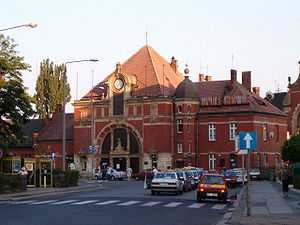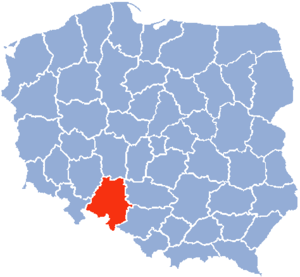Opole Voivodeship
| Opole Voivodeship Województwo opolskie | |||
|---|---|---|---|
| Voivodeship | |||
 | |||
| |||
.png) | |||
 | |||
| Coordinates (Opole): 50°40′N 17°56′E / 50.667°N 17.933°E | |||
| Country |
| ||
| Capital | Opole | ||
| Counties | |||
| Area | |||
| • Total | 9,412.5 km2 (3,634.2 sq mi) | ||
| Population (2006) | |||
| • Total | 1,044,346 | ||
| • Density | 110/km2 (290/sq mi) | ||
| • Urban | 549,334 | ||
| • Rural | 495,012 | ||
| Car plates | O | ||
| Website | http://www.umwo.opole.pl/ | ||
| |||
Opole Voivodeship, or Opole Province[1] (Polish: województwo opolskie [vɔjɛˈvut͡stfɔ ɔˈpɔlskʲɛ]), is a Polish voivodeship, or province, created on January 1, 1999, out of the former Opole Voivodeship and parts of Częstochowa Voivodeship, pursuant to the Polish local government reforms adopted in 1998. The province's name derives from that of the region's capital and largest city, Opole, pronounced [ɔˈpɔlɛ]. It is part of Silesia, and the territorial successor of the former German Upper Silesia, which had the same city — then Oppeln — as its capital. Almost all of the present territory was part of Germany except for the two Gminas of Praszka and Rudniki.
Opole Voivodeship is bordered by Lower Silesian Voivodeship to the west, Greater Poland and Łódź Voivodeships to the north, Silesian Voivodeship to the east, and the Czech Republic to the south.
Opole Province's geographic location, economic potential, and its population's level of education make it an attractive business partner for other Polish regions (especially Lower Silesian and Silesian Voivodeships) and for foreign investors. Formed in 1997, the Praděd/Pradziad Euroregion has facilitated economic, cultural and tourist exchanges between the border areas of Poland and the Czech Republic.
Geography
The voivodeship lies in southwestern Poland, the major part on the Silesian Lowland (Nizina Śląska). To the east, the region touches upon the Silesian Upland (Silesian Uplands, Wyżyna Śląska) with the famous Saint Anne Mountain; the Sudetes range, the Opawskie Mountains, lies to the southwest. The Oder River cuts across the middle of the voivodeship. The northern part of the voivodeship, along the Mała Panew River, is densely forested, while the southern part consists of arable land.
History
Until 1945 virtually all of the present Polish voivodeship was part of the Prussian province of "Upper Silesia". The two Gminas of Praszka and Rudniki were already part of Poland in 1939, and were previously part of Russian Congress Poland until 1918. After World War II Silesia was annexed by Poland as a result of the Allied Powers agreement on the realignment of Eastern European states that had been reached at the Yalta Conference (February 1945). The Opole region was originally merged with the pre-existing Polish Silesian Voivodeship, until in 1950 it regained its status as a region, thanks to a reform of Polish regions. The towns of Brzeg and Namysłów were later transferred to Opole from the neighbouring Lower Silesian Voivodeship. As the result of a third regional shake-up in 1975 the voivodeship was broken up and Racibórz was transferred to the new Katowice Voivodeship whilst a part of Olesno was given up to the Częstochowa Voivodeship.
Finally, as the result of a 1999 land reform; the objective of which was to restore the historical voivodeships of Poland, the Opole Voivodeship as we know it today came into being. Originally, the government, advised by prominent historians, had wanted to disestablish Opolskie and partition its territory between the more historically ‘Polish’ regions of Lower Silesia and Silesia. The plan was that Brzeg and Namysłów, as the Western part of the region, were to be transferred to Lower Silesia, whilst the rest was to become, along with a part of the Częstochowa Voivodeship, an integral part of the new ‘Silesian’ region. However, the plans resulted in an outcry from the German minority population of Opolskie, who feared that should their region be abolished, they would lose all hope of regional representation (in the proposed Silesian Region, they would have formed a very small minority amongst a great number of ethnic Poles). To the surprise of many of the ethnic Germans in Opole however, the local Polish Silesian population and groups of ethnic Poles also rose up to oppose the planned reforms; this came about as a result of an overwhelming feeling of attachment to the voivodeships that were scheduled to be ‘redrawn’, as well as a fear of ‘alienation’ should one find themselves residing in a new, unfamiliar region.
The solution came in late 1999, when Olesno was, after 24 years apart, finally reunited with the Opole Voivodeship to form the new legally defined region. A historic moment came in 2006 when the town of Radłów changed its local laws to make German, alongside Polish, the district’s second official language; thus becoming the first town in the region to achieve such a feat.
Demographics
The Opole Voivodeship is the smallest region in the administrative makeup of the country in terms of both area and population. About 15% of the one million inhabitants of this voivodeship are ethnic Germans, which constitutes 90% of all ethnic Germans in Poland. As a result, many areas are officially bi-lingual in Opolskie and the German language, and culture plays a significant role in education in the region.Tourism

The Opole voivodeship is a green region with three large lakes: Turawskie, Nyskie, and Otmuchowskie (the latter two are connected). The Opawskie Mountains are extremely popular. The region also includes the castle in Brzeg, built during the reign of the Piast dynasty—pearl of the Silesian Renaissance, the Franciscan monastery on top of Saint Anne Mountain, as well as the medieval defence fortifications in Paczkow (referred to as the Polish Carcassonne).
The region has the warmest climate in the country.
Protected areas in Opole Voivodeship include the following three areas designated as Landscape Parks:
Transportation
The transport route from Germany to Ukraine runs through Opole. The region has four border crossings, and direct rail connections to all important Polish cities, as well as to Frankfurt, Munich, Budapest, Kiev, and the Baltic ports.
Cities and towns
 Opole, the voivodeship's capital  Nysa  Brzeg town hall  Krapkowice |
The voivodeship contains 35 cities and towns. These are listed below in descending order of population (according to official figures for 2006[2] ):
- Opole (128,034)
- Kędzierzyn-Koźle (65,572)
- Nysa (47,283)
- Brzeg (38,303)
- Kluczbork (25,910)
- Prudnik (23,133)
- Strzelce Opolskie (20,059)
- Krapkowice (18,112)
- Namysłów (16,557)
- Głuchołazy (14,887)
- Głubczyce (13,333)
- Zdzieszowice (13,329)
- Olesno (10,106)
- Ozimek (9,944)
- Grodków (8,771)
- Zawadzkie (8,331)
- Praszka (8,230)
- Paczków (8,147)
- Niemodlin (6,849)
- Kietrz (6,365)
- Wołczyn (6,139)
- Gogolin (6,077)
- Lewin Brzeski (5,826)
- Głogówek (5,816)
- Otmuchów (5,261)
- Dobrodzień (4,168)
- Byczyna (3,677)
- Kolonowskie (3,432)
- Baborów (3,175)
- Leśnica (2,945)
- Prószków (2,713)
- Biała Prudnicka (2,653)
- Gorzów Śląski (2,606)
- Korfantów (1,883)
- Ujazd (1,652)
Administrative division
Opole Voivodeship is divided into 12 counties (powiats): 1 city county and 11 land counties. These are further divided into 71 gminas.
The counties are listed in the following table (ordering is by decreasing population).
| English and Polish names |
Area (km²) |
Population (2006) |
Seat | Other towns | Total gminas |
| City counties | |||||
| Opole | 96 | 128,034 | 1 | ||
| Land counties | |||||
| Nysa County powiat nyski |
1,224 | 145,640 | Nysa | Głuchołazy, Paczków, Otmuchów, Korfantów | 9 |
| Opole County powiat opolski |
1,587 | 134,874 | Opole * | Ozimek, Niemodlin, Prószków | 13 |
| Kędzierzyn-Koźle County powiat kędzierzyńsko-kozielski |
625 | 102,118 | Kędzierzyn-Koźle | 6 | |
| Brzeg County powiat brzeski |
877 | 92,361 | Brzeg | Grodków, Lewin Brzeski | 6 |
| Strzelce County powiat strzelecki |
744 | 80,828 | Strzelce Opolskie | Zawadzkie, Kolonowskie, Leśnica, Ujazd | 7 |
| Kluczbork County powiat kluczborski |
852 | 70,082 | Kluczbork | Wołczyn, Byczyna | 4 |
| Olesno County powiat oleski |
974 | 68,269 | Olesno | Praszka, Dobrodzień, Gorzów Śląski | 7 |
| Krapkowice County powiat krapkowicki |
442 | 67,926 | Krapkowice | Zdzieszowice, Gogolin | 5 |
| Prudnik County powiat prudnicki |
571 | 59,931 | Prudnik | Głogówek, Biała Prudnicka | 4 |
| Głubczyce County powiat głubczycki |
673 | 50,326 | Głubczyce | Kietrz, Baborów | 4 |
| Namysłów County powiat namysłowski |
748 | 43,957 | Namysłów | 5 | |
| * seat not part of the county | |||||
Economy

The Opole voivodeship is an industrial as well as an agricultural region. With respect to mineral resources, of major importance are deposits of raw materials for building: limestone (Strzelce Opolskie), marl (near Opole), marble, and basalt. The favourable climate, fertile soils, and high farming culture contribute to the development of agriculture, which is among the most productive in the country.
A total of nineteen industries are represented in the voivodeship. The most important are cement and lime, furniture, food, car manufacturing, and chemical industries. In 1997, the biggest production growth in the area was in companies producing wood and wood products, electrical equipment, machinery and appliances, as well as cellulose and paper products. In 1997, the top company in the region was Zakłady Azotowe S.A. in Kędzierzyn-Koźle, whose income was over PLN 860 million. The voivodship's economy consists of more than 53,000 businesses, mostly small and medium-sized, employing over 332,000 people. Manufacturing companies employ over 89,000 people; 95.7% of all the region's business operate in the private sector.
Universities
There are three state-run universities in the region: the Opole University, the Opole University of Technology, and the State Medical College. All of them are based in the voivodeship's capital. Among the region's private schools, the Opole School of Management and Administration has been certified as a degree-granting institution by the Ministry of National Education.
- Opole University of Technology
- Opole University
- State Medical College
- Opole School of Management and Administration
- Bogdan Jański College
- The State Higher Vocational School in Nysa, PWSZ in NYSA
Most popular surnames in the region
Previous Opole voivodeships

Opole Voivodeship was also a unit of administrative division and local government in Poland between 1975 and 1998.
Major cities and towns (population in 1995):
- Opole, capital city (130,600)
- Kędzierzyn-Koźle (70,700)
- Nysa (49,000)
- Brzeg (39,900)
- Kluczbork (26,900)
- Prudnik (24,300)
- Strzelce Opolskie (21,900)
- Krapkowice (20,100)
Opole Voivodeship (1950–1975)
This administrative region of the People's Republic of Poland (1950–1975) was created as a result of the partition of Katowice Voivodeship in 1950.
References
- ↑ Arkadiusz Belczyk,Tłumaczenie polskich nazw geograficznych na język angielski [Translation of Polish Geographical Names into English], 2002-2006.
- ↑ http://www.stat.gov.pl/gus/45_655_PLK_HTML.htm
External links
- Opolskie - photogallery
- Self-Government of the Opolskie Voivodeship
- Opolski Urząd Wojewódzki Official website
| ||||||||||
| |||||||
| |||||||||||||||||||||||||||||||||||||||||||||||||||||||||||||||||||||||||||||||||||||||||||||||||||||||||||||||
Coordinates: 50°38′54″N 17°54′02″E / 50.64833°N 17.90056°E

